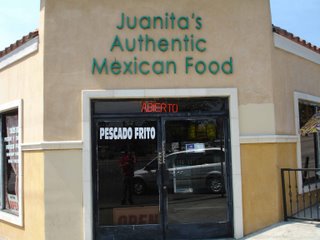Burrito?
The more I try to think about the qualities that best describe the perfect burrito, the more I seem to confuse myself and find myself at a loss for a shining paragon of burrito idealism. Or I just haven't found an AMAZING burrito in Los Angeles.
Something I've neglected thus far is to establish any sort of clarity about what constitutes my estimation of a high quality burrito. I wanted to get a couple posts under my belt to get a handle on the language of burrito commentary before tackling any sort of rating system or rule for burrito ranking. I will attempt an exploratory stab at this, but first I think it's important to establish that there are a couple different basic types of burritos out there. For expedience I will classify them into three groups for now:
1) Traditional, San Diego/Northern Mexico style burrito. (Yucca's)
Cheap flour tortilla, Dollop o' Beans, Dollop o' meat:
I've never been to Mexico (pathetic) but from what I've read in books and articles, and have been told by people who've eaten there, is that the origin of the burrito as we know it came from street vendors who would push a cart around with a steaming pot of beans that they would dollop into a flour tortilla, providing a cheap, filling meal for day laborers and the like. This basic offering was quickly modified by the addition of a second steaming pot of simmered meat like chile con carne (chunks of beef in red sauce). I don't think rice was ever part of the equation down there and wasn't really introduced until late in the 20th century as burrito vendors sought ways to fill a burrito for little added cost.
2) Authentic Burrito, LA Style?, with rice (Tacos Mexico, Burrito King)
Not that "authentic burrito" is a real name or even a satisfactory one, but it'll have to do for the purposes of this amateur food blog. I think of a "authentic" burrito as the type of thing you can get at mexican restaurants that cover the LA food landscape. Places like Tacos Mexico and Los/Dos Burritos serve this burrito from west hollywood to deep in the west san fernando valley. What seperates it from the more traditional burrito is of course the addition of mexican rice, but also the vastly increased number of meat options. Where the original burritos were probably just a bunch of beef and beans slopped in a cheap crumbly flour tortilla, these burritos incorporate nearly every part of the animal to please your culinary sensibilities. Tongue, brain, tribe are the wilder options, along with traditional fillings like carnitas, machaca, al pastor, asada etc.
3) NÜburrito / Post-Burrito / Health(ier) Chain Burrito. (chipotle, sharky's, anna's taqueria)
This burrito is essentially the same as the authentic burrito, at least nominally. It usually contains the same stuff: rice beans, meat, but it is designed by chefs and made with more transparency and healthier (read: more expensive) ingredients. This means a healthier, maybe baked carnitas, lard-free beans, etc. more later...
Something I've neglected thus far is to establish any sort of clarity about what constitutes my estimation of a high quality burrito. I wanted to get a couple posts under my belt to get a handle on the language of burrito commentary before tackling any sort of rating system or rule for burrito ranking. I will attempt an exploratory stab at this, but first I think it's important to establish that there are a couple different basic types of burritos out there. For expedience I will classify them into three groups for now:
1) Traditional, San Diego/Northern Mexico style burrito. (Yucca's)
Cheap flour tortilla, Dollop o' Beans, Dollop o' meat:
I've never been to Mexico (pathetic) but from what I've read in books and articles, and have been told by people who've eaten there, is that the origin of the burrito as we know it came from street vendors who would push a cart around with a steaming pot of beans that they would dollop into a flour tortilla, providing a cheap, filling meal for day laborers and the like. This basic offering was quickly modified by the addition of a second steaming pot of simmered meat like chile con carne (chunks of beef in red sauce). I don't think rice was ever part of the equation down there and wasn't really introduced until late in the 20th century as burrito vendors sought ways to fill a burrito for little added cost.
2) Authentic Burrito, LA Style?, with rice (Tacos Mexico, Burrito King)
Not that "authentic burrito" is a real name or even a satisfactory one, but it'll have to do for the purposes of this amateur food blog. I think of a "authentic" burrito as the type of thing you can get at mexican restaurants that cover the LA food landscape. Places like Tacos Mexico and Los/Dos Burritos serve this burrito from west hollywood to deep in the west san fernando valley. What seperates it from the more traditional burrito is of course the addition of mexican rice, but also the vastly increased number of meat options. Where the original burritos were probably just a bunch of beef and beans slopped in a cheap crumbly flour tortilla, these burritos incorporate nearly every part of the animal to please your culinary sensibilities. Tongue, brain, tribe are the wilder options, along with traditional fillings like carnitas, machaca, al pastor, asada etc.
3) NÜburrito / Post-Burrito / Health(ier) Chain Burrito. (chipotle, sharky's, anna's taqueria)
This burrito is essentially the same as the authentic burrito, at least nominally. It usually contains the same stuff: rice beans, meat, but it is designed by chefs and made with more transparency and healthier (read: more expensive) ingredients. This means a healthier, maybe baked carnitas, lard-free beans, etc. more later...








